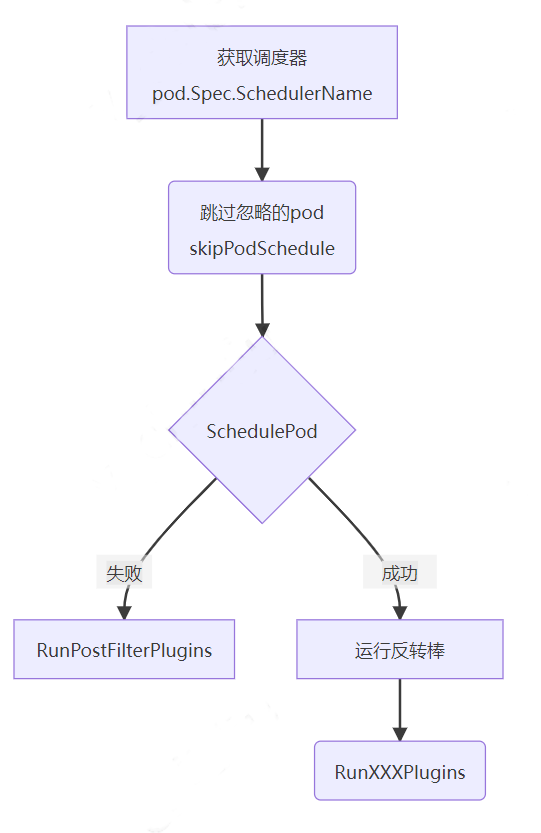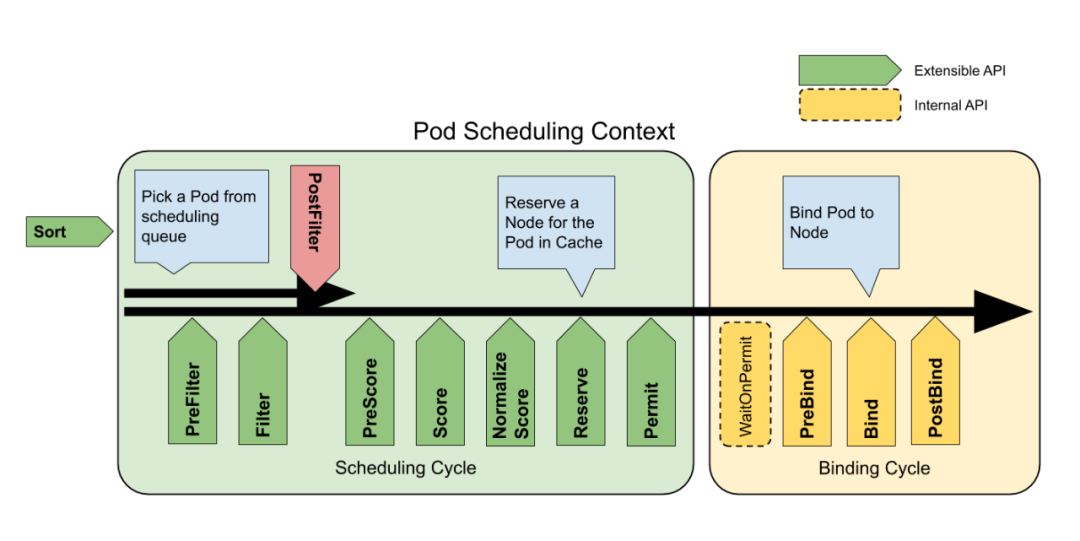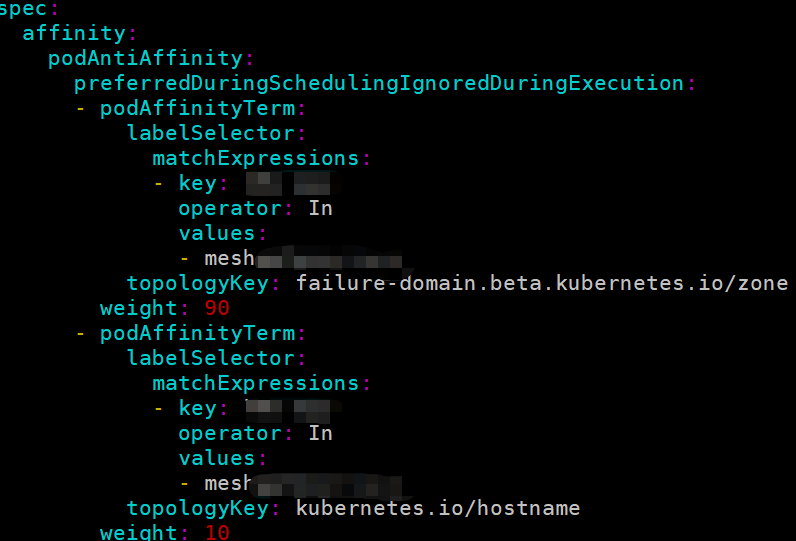KubernetesKubernetes调度器
导语 | kubernetes调度器,通过watch机制来发现集群中新创建且未调度的pod,通过过滤node列表,打分策略,以及各个时机的插件调用机制,选择合适的node与之绑定。
一、调度队列
同一时刻会有多个pod等待调度,会把等待调度的pod放到activeQ中(PriorityQueue),然后周期性(1s)的进行调度,对于调度超时( DefaultPodMaxInUnschedulablePodsDuration 5m)会放入队列中,再次重新调度。二、单次调度
用下图来说明单个调度的流转逻辑。
注意:一个集群中可以有多个调度器,所以首先需要根据pod中的spec参数获取调度器名称
跳过<font style="color:rgb(34, 34, 34);">pod:skipPodSchedule</font>, 过滤调不需要调度的pod,比如正在删除中的pod,上个调度周期正在处理中的pod
筛选<font style="color:rgb(34, 34, 34);">pod:SchedulePod</font>,计算并预选出适合的node
如果筛选失败,则调用<font style="color:rgb(34, 34, 34);">RunPostFilterPlugins</font>; 如果筛选成功,则调用插件:<font style="color:rgb(34, 34, 34);">RunXXXPlugins</font>,开始调用配置的插件列表,从Reserve插件到<font style="color:rgb(34, 34, 34);">MultiPoint</font>依次按照埋点调用。
对于大规模集群,单此调度要遍历所有的node么?这是一个值得思考的问题。默认调度器给出的答案是根据集群规模自适应调度数量。
- 对于小规模集群,node数小于100, 遍历所有node。
- 对于大规模集群,node数大于100,且配置的百分比小于100%时:按照node数量的一定百分比遍历,区间范围是[5,100]。
- 计算公式是
三、调度过程
调度过程分为3个步骤:过滤,打分,筛选,代码步骤如下: 省略非必要代码
// node快照if err := sched.Cache.UpdateSnapshot(sched.nodeInfoSnapshot); err != nil {return result, err}// 过滤feasibleNodes, diagnosis, err := sched.findNodesThatFitPod(ctx, fwk, state, pod)if err != nil {return result, err}// 打分priorityList, err := prioritizeNodes(ctx, sched.Extenders, fwk, state, pod, feasibleNodes)if err != nil {return result, err}// 随机筛选host, err := selectHost(priorityList)
(一)过滤
可用的node列表:- 插件过滤:
<font style="color:rgb(34, 34, 34);">RunPreFilterPlugins</font>如果插件执行失败,那么返回所有node可用,如果插件返回不可调度,则返回失败,终止本次调度。 - 获取
<font style="color:rgb(34, 34, 34);">node allNodes, err := sched.nodeInfoSnapshot.NodeInfos().列表()</font> - 抢占式pod的status字段中
<font style="color:rgb(34, 34, 34);">NominatedNodeName</font>设置后,会优先抢占同名的node。 <font style="color:rgb(34, 34, 34);">allNode</font>和<font style="color:rgb(34, 34, 34);">preFilter</font>返回的node求交集。
(二)打分
根据优先级选择合适的node列表:<font style="color:rgb(34, 34, 34);">prioritizeNodes</font>
+ 如果没有开启打分插件,返回所有node list。
+ 打分插件逐次调用<font style="color:rgb(34, 34, 34);">RunPreScorePlugins</font>—><font style="color:rgb(34, 34, 34);">RunScorePlugins</font>
### (三)筛选
相同优先级列表下,获取score最大值的node,如果存在多个相同分数,则随机一个。
四、插件机制
插件分为了调度和绑定两大类,划分成了多个时机调用,如下图:
(一)插件类型
对于pod的调度过程,划分了多个点,每个点调用对应的插件列表,目前支持如下多种类型插件:
// QueueSort is a list of plugins that should be invoked when sorting pods in the scheduling queue.QueueSort PluginSet `json:"queueSort,omitempty"`// PreFilter is a list of plugins that should be invoked at "PreFilter" extension point of the scheduling framework.PreFilter PluginSet `json:"preFilter,omitempty"`// Filter is a list of plugins that should be invoked when filtering out nodes that cannot run the Pod.Filter PluginSet `json:"filter,omitempty"`// PostFilter is a list of plugins that are invoked after filtering phase, but only when no feasible nodes were found for the pod.PostFilter PluginSet `json:"postFilter,omitempty"`// PreScore is a list of plugins that are invoked before scoring.PreScore PluginSet `json:"preScore,omitempty"`// Score is a list of plugins that should be invoked when ranking nodes that have passed the filtering phase.Score PluginSet `json:"score,omitempty"`// Reserve is a list of plugins invoked when reserving/unreserving resources// after a node is assigned to run the pod.Reserve PluginSet `json:"reserve,omitempty"`// Permit is a list of plugins that control binding of a Pod. These plugins can prevent or delay binding of a Pod.Permit PluginSet `json:"permit,omitempty"`// PreBind is a list of plugins that should be invoked before a pod is bound.PreBind PluginSet `json:"preBind,omitempty"`// Bind is a list of plugins that should be invoked at "Bind" extension point of the scheduling framework.// The scheduler call these plugins in order. Scheduler skips the rest of these plugins as soon as one returns success.Bind PluginSet `json:"bind,omitempty"`// PostBind is a list of plugins that should be invoked after a pod is successfully bound.PostBind PluginSet `json:"postBind,omitempty"`// MultiPoint is a simplified config section to enable plugins for all valid extension points.MultiPoint PluginSet `json:"multiPoint,omitempty"`
(二)插件列表
默认调度器,实现了多种插件不用特性的插件,目前支持的列表如下,下面举几个例子说明。对于打分插件,必须实现如下接口,且每个插件打分范围是[0, 100]
"PrioritySort" :"DefaultBinder""DefaultPreemption""ImageLocality""InterPodAffinity""NodeAffinity""NodeName""NodePorts""NodeResourcesBalancedAllocation""NodeResourcesFit""NodeUnschedulable""NodeVolumeLimits""AzureDiskLimits""CinderLimits""EBSLimits""GCEPDLimits""PodTopologySpread""SelectorSpread""ServiceAffinity""TaintToleration""VolumeBinding""VolumeRestrictions""VolumeZone"
type ScorePlugin interface {Plugin// Score is called on each filtered node. It must return success and an integer// indicating the rank of the node. All scoring plugins must return success or// the pod will be rejected.Score(ctx context.Context, state *CycleState, p *v1.Pod, nodeName string) (int64, *Status)// ScoreExtensions returns a ScoreExtensions interface if it implements one, or nil if does not.ScoreExtensions() ScoreExtensions}
(三)插件特性
图像定位
<font style="color:rgb(34, 34, 34);">ImageLocality</font>:本地镜像打分插件,计算分数规则如下:
注意:这里不是指单个containner,而是一个pod中的所有container的打分之和。为什么范围是23mb到1000mb?可以想一想。
节点关联
<font style="color:rgb(34, 34, 34);">NodeAffinity</font>:node亲和性和反亲和性,提供了两种策略配置。
- 对于必选策略
<font style="color:rgb(34, 34, 34);">RequiredDuringSchedulingIgnoredDuringExecution</font>,如果匹配未成功,则在<font style="color:rgb(34, 34, 34);">PreFilter</font>阶段返回失败,终止调度。 - 对于首先策略
<font style="color:rgb(34, 34, 34);">PreferredDuringSchedulingIgnoredDuringExecution</font>,如果匹配未成功,则尝试其他node也失败,调度器仍然会调度改pod。亲和性,反亲和性是用来影响打分数值(正负分)weight
比如业务逻辑中的配置如下图,期望是一个node上只调度一个这种pod,但是配置了首选策略。所以当node数小于pod数时,是会出现一个node上有多个此类pod,会有一定的影响。
// 亲和性,反亲和性判定判定if hasPreferredAffinityConstraints || hasPreferredAntiAffinityConstraints {for _, existingPod := range podsToProcess {pl.processExistingPod(state, existingPod, nodeInfo, pod, topoScore)}topoScores[atomic.AddInt32(&index, 1)] = topoScore}

污点耐受
<font style="color:rgb(34, 34, 34);">TaintToleration</font>:污点插件,提供了过滤,预打分,打分,打分标准化(平行扩展到0到100)接口。
比如业务中打了污点,那么一般pod是不会调度到此pod上的。
// 尽可能不调度TaintEffectPreferNoSchedule TaintEffect = "PreferNoSchedule"// 一定不调度TaintEffectNoSchedule TaintEffect = "NoSchedule"// 一定不调度且驱逐TaintEffectNoExecute TaintEffect = "NoExecute"

五、调度器配置
一般情况下,scheduler会起多副本进行容灾。
{"name": "BalancedResourceAllocation","weight": 1},{"name": "EvenPodsSpreadPriority","weight": 1},{"name": "InterPodAffinityPriority","weight": 1},{"name": "LeastRequestedPriority","weight": 1},{"name": "NodeAffinityPriority","weight": 1},{"name": "NodePreferAvoidPodsPriority","weight": 10000},{"name": "SelectorSpreadPriority","weight": 1},{"name": "TaintTolerationPriority","weight": 1}
六、如何自定义pod调度
目前有2种常用方法:(一)扩展模式
实现t<font style="color:rgb(34, 34, 34);">ype Extender struct</font>接口,并且在策略文件scheduler-policy-config中配置扩展访问方式
"extenders": [{"urlPrefix": "http://xxx/prefix","filterVerb": "filter","weight": 1,"bindVerb": "bind","enableHttps": false}]
(二)多调度器
在需要自定义调度的pod中,指定pod的<font style="color:rgb(34, 34, 34);">spec.schedulerName</font> 为自定义的调度器名称。实现自定义调度器。部署自定义的调度器deployment。
在新版本1.19之后建议扩展自定义调度框架,如下例:
import (scheduler "k8s.io/kubernetes/cmd/kube-scheduler/app")func main() {command := scheduler.NewSchedulerCommand(scheduler.WithPlugin("my-plugin", MyPlugin))if err := command.Execute(); err != nil {fmt.Fprintf(os.Stderr, "%v\n", err)}}

